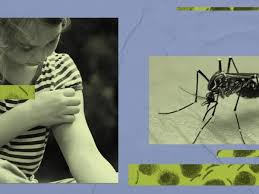Context:
National Centre for Disease Control (NCDC) data reveals that in the last two years, typhoid, dengue, malaria, scrub typhus, and influenza have emerged as a public health concern.
Key highlights:
- Typhoid, which is a water-borne disease, was the most common disease between the years 2022 and 2024.
- It was followed by vector-borne diseases such as dengue and malaria. Despite a decline in occurrence, scrub typhus remained a significant concern, especially in South India.
- Climate change factors such as temperature, rainfall, and humidity have been exacerbating the spread of this disease in the region.
| Vector | Disease caused | Type of pathogen | |
| Mosquito | Aedes | ChikungunyaDengueLymphatic filariasisRift Valley feverYellow FeverZika | VirusVirusParasiteVirusVirusVirus |
| Anopheles | Lymphatic filariasisMalaria | ParasiteParasite | |
| Culex | Japanese encephalitisLymphatic filariasisWest Nile fever | VirusParasiteVirus | |
About Typhoid
- Causative agent: Salmonella enterica serotype Typhi (S. Typhi) – a gram-negative bacterium.
- Transmission: Primarily water-borne, spread through contaminated food or water.
- Impact in India:
- Approximately 4.5 million cases and 9,000 deaths annually.
- 30% increase in cases observed during the 2023 monsoon season.
Government Initiatives:
- Vaccination: Typhoid Conjugated Vaccine (TCV) is mandated at birth, with the first dose given between 9-12 months. This strategy aims to build immunity early.
- Improved Sanitation: Focus on improving access to clean drinking water and proper sanitation facilities can significantly reduce water contamination, a key transmission route.
About Dengue
- Causative agent: Dengue virus – transmitted by Aedes mosquitoes.
- Transmission: Mosquito-borne, transmitted by Aedes mosquitoes breeding in peri-domestic environments (around homes).
- Outbreaks: As of mid-November 2023, around 200,000 cases reported with Bengaluru and Delhi witnessing significant cases.
- Risk factors: Warmer temperatures create ideal breeding grounds for Aedes mosquitoes, increasing the risk.
- Vulnerable population: Pregnant women and infants are particularly susceptible to severe dengue.
Government Initiatives:
- Vector Control: Fogging campaigns and larvicide application target mosquito breeding grounds, aiming to reduce Aedes mosquito populations.
- Public Awareness Campaigns: Educating the public about preventive measures like wearing full sleeves and using mosquito nets helps minimize exposure.
- Vaccine Development: The Serum Institute of India (SII) developed Dengvaxia, the first indigenous dengue vaccine, offering additional protection.
About Malaria
- Causative agent: Plasmodium parasites – transmitted by infected female Anopheles mosquitoes.
- Species: Five parasite species cause malaria in humans, with Plasmodium falciparum and Plasmodium vivax posing the greatest threat.
- Prevalence in India: In 2022, India accounted for 66% of the 5.2 million malaria cases reported in Southeast Asia.
- High-risk groups: Pregnant women, elderly adults, and young children are more vulnerable to severe malaria.
Government Initiatives:
- National Vector Borne Disease Control Programme (NVBDCP): This overarching program coordinates malaria control efforts across the country.
- Multi-pronged Approach: The NVBDCP utilizes various strategies like:
- Indoor Residual Spraying (IRS) with insecticides.
- Distribution of Long-Lasting Insecticide Treated Nets (LLINs).
- Early diagnosis and treatment with Artemisinin-combination therapies (ACTs).
- Vaccine Hope: The pre-qualification of the R21/Matrix-M malaria vaccine by WHO in 2023 offers a promising tool for future control efforts.
Scrub Typhus
- It is also known as bush typhus.
- Causative agent: Orientia tsutsugamushi bacteria – transmitted by larval mites (chiggers).
- Transmission: Spread through bites of infected chiggers.
- Symptoms: Fever, headache, body aches, and sometimes a rash.
Government Initiatives:
- Improved surveillance: Increased awareness and monitoring of scrub typhus cases helps in timely diagnosis and treatment.
- Antibiotic availability: Ensuring access to Doxycycline, a broad-spectrum antibiotic effective against scrub typhus, is crucial.

